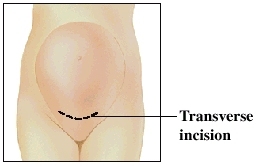VBAC (Vaginal Birth After Cesarean)
You've had a cesarean birth. Now you may wonder if you can try vaginal birth with this baby. It's likely you can. VBAC is often a success. To find out more about VBAC, read this health sheet. Then discuss it with your healthcare provider.

To try VBAC, you must have had a transverse incision in your uterus.
Is VBAC Right for Me?
VBAC may be right for you if:
-
A transverse (side-to-side) incision in the uterus was used for all your cesarean births. (Be aware: Your skin incision may not match the incision in your uterus.)
-
You have no health problems that would prevent a VBAC.
-
The baby is in a normal head-down position.
How Can I Benefit?
When compared with a cesarean delivery, VBAC has certain benefits. These include:
-
Less time in the hospital. Because VBAC does not require surgery, you can go home sooner.
-
A shorter recovery. With VBAC, you won't have an abdominal incision. This means you should feel better faster than the last time you gave birth.
-
Fewer health risks. VBAC reduces the chances of excess bleeding, infection, and death.
Is VBAC Safe?
For women who try VBAC, the risk of rupture (when an incision site pulls apart) can be a concern. Rest assured that rupture is very rare. A transverse incision in the uterus often heals so well that a scar can't even be found.
Prepare for VBAC
As with any birth, this one will go more smoothly if you are prepared. Make sure the hospital where you will have your baby is friendly toward VBAC. Also be sure your support person is committed to helping you.
-
Work closely with your healthcare team. They support you and your choice to try VBAC. They will do all they can to promote a safe, healthy birth.
-
Talk with your doctor about your options for anesthesia and other ways of controlling pain.
-
Pick a dedicated support person. He or she can motivate you to help labor progress.
-
Refresh your skills. Take a childbirth class. Learn ways to relax, how to breathe through pain, and how to push.
Know What to Expect
With VBAC, you are likely to be told to leave for the hospital as soon as labor begins. After you are admitted, you may have a blood test as well as an exam. An IV (intravenous) line might be started to supply fluids or medications. Throughout labor, you and your baby will be monitored to ensure your well-being.

To make the most of your effort, breathe and push as coached by your healthcare provider.
Help Labor Along
The length of labor and the pushing phase vary with each birth. But there are things you can do to help labor progress:
-
Keep moving. Walk as much as you can. If you have an intense contraction, lean on your support person, against a wall, or over a table.
-
Change position when you need to. Squat, kneel, or sit in a chair. If you've had anesthesia and your legs are numb, sit upright in bed.
-
Rest by lying on your side between contractions.
-
Push without fear. The old incision in your uterus has healed and is strong.

